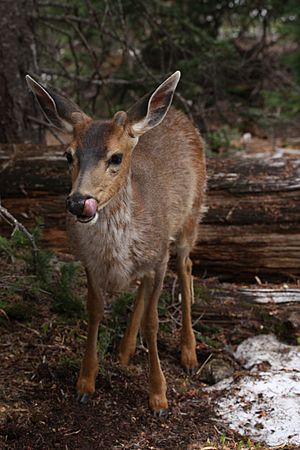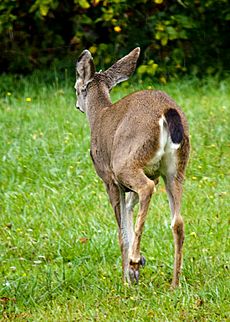Black-tailed deer facts for kids
Quick facts for kids Black-tailed deer |
|
|---|---|
 |
|
| Male black-tailed deer (Olympic National Park) | |
| Scientific classification |
|
| Kingdom: | Animalia |
| Phylum: | Chordata |
| Class: | Mammalia |
| Order: | Artiodactyla |
| Family: | Cervidae |
| Subfamily: | Capreolinae |
| Genus: | Odocoileus |
| Species: | |
| Subspecies: |
O. h. columbianus
|
| Trinomial name | |
| Odocoileus hemionus columbianus (Richardson, 1829)
|
|
Black-tailed deer are a special type of deer found in the Pacific Northwest of North America. They are actually a subspecies of the larger mule deer. There are two main kinds: the Columbian black-tailed deer and the Sitka deer.
The Columbian black-tailed deer lives from Northern California up through the United States and into coastal British Columbia, Canada. The Sitka deer lives along the coast in British Columbia, southeast Alaska, and even on Kodiak Island.
Contents
Where Do Black-Tailed Deer Live?
Black-tailed deer live along the Pacific coast, from western California all the way up to Alaska. As you move further inland from the coast, you'll start to see their relatives, the larger mule deer, instead.
These deer are very common in California, western Oregon, Washington, and throughout coastal and interior British Columbia. You can also find them north into the Alaskan panhandle. Black-tailed deer are also a popular game animal for hunters.
What Kind of Deer Are They?
Scientists agree that black-tailed deer are a subspecies of the mule deer. This means they are a specific type within the mule deer family. The black-tailed deer group includes two subspecies: the Columbian black-tailed deer and the Sitka deer.
Where Do Black-Tailed Deer Like to Live?
These deer love to live on the edge of forests. They prefer areas where the forest meets open spaces. Dark, thick forests don't have enough underbrush or grass for them to eat. Completely open areas don't offer enough places to hide or shelter from bad weather.
An interesting fact is that black-tailed deer can eat western poison oak! This plant is irritating to humans, but the deer don't seem bothered by it.
Staying Safe Around Deer
Black-tailed deer are often most active during dawn (sunrise) and dusk (sunset). This is when they are frequently involved in accidents with cars. Drivers need to be careful, especially in areas where deer live.
What Do Black-Tailed Deer Eat and How Do They Have Babies?
Deer are known as browsers, which means they eat leaves, twigs, and shrubs. In winter and early spring, they munch on plants like Douglas fir, western red cedar, and red huckleberry. They also eat ferns and lichens found on trees.
From late spring to fall, their diet changes. They eat grasses, blackberries, apples, and other plants like fireweed and maple.
Mating Season
The mating season for black-tailed deer, also called the 'rut,' happens in November and early December. During this time, male deer (bucks) might be seen running across roads as they chase female deer (does). After the rut, bucks often rest and recover. They might have broken antlers and lose weight.
Bucks drop their antlers between January and March. These dropped antlers provide important calcium and other nutrients for other animals in the forest. New antlers start to grow back in April and continue until August.
Baby Deer (Fawns)
Female deer are pregnant for about 6 to 7 months. Baby deer, called fawns, are usually born in late May and June. Most often, a doe will have twins, but young does might only have one fawn. Sometimes, triplets can be born!
Newborn fawns weigh about 2.7 to 4 kg (6.0 to 8.8 lb). For their first week or so, they have no scent. This helps their mother hide them safely while she goes to find food. She needs to eat a lot to make enough milk for her fawns. Even though does are great mothers, about 45% to 70% of fawns do not survive. Does are very protective of their young and see humans as possible dangers.
How Deer Communicate
Deer use scents and special chemicals called pheromones to communicate. These come from glands on their lower legs. One gland produces an alarm scent if there's danger. Another helps deer recognize each other. A third gland between their toes leaves a scent trail as they walk.
Deer have excellent eyesight and a very good sense of smell. Their large ears can move separately, helping them pick up any unusual sounds that might mean danger is near.
You might see deer eating by the side of the road at dawn, dusk, or on moonlit nights. They are often attracted to wooded areas next to roads and open, grassy places like golf courses. Always drive carefully, because if you see one deer cross the road, one or two more might be right behind it!


